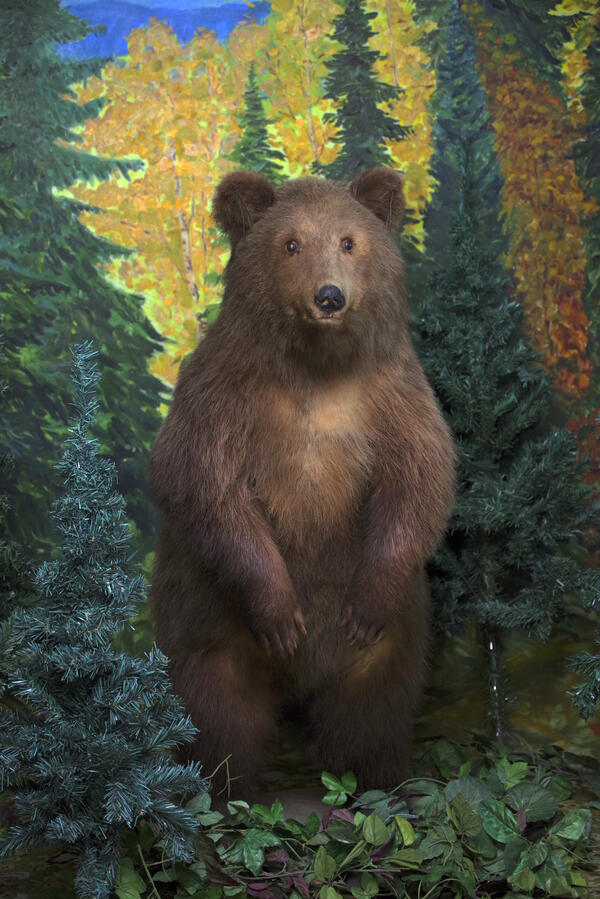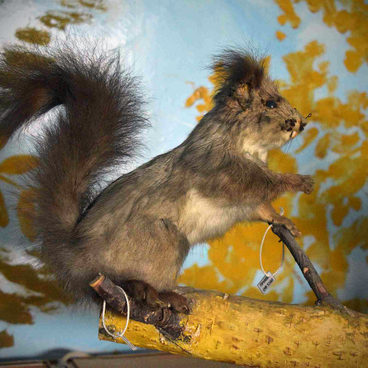The Russian word ‘pestun’ refers to an older bear cub that stays with its mother and helps the latter look after new offspring. The name originates from the Russian verb ‘pestovat’, which means to look after one’s siblings. Usually there is only one such bear cub with the mother, and most frequently it is a female. Exceptions are made if a she-bear gave birth to two males the previous time. Pestun’s role is to follow the sow and to look after its cubs, i.e. to essentially be their nanny.
Baby cubs are born in dens, which are created under large rocks and uprooted trees, in crevices, and at times, in caves or large burrows. The space for sleeping in such dens is not very large, and yet she-bears take the job of arranging them very seriously. Inside, a shelter for the winter is lined with moss, dry leaves and branches of conifers.
If a sow is disturbed in its den, it runs away and practically never returns to this home even if there are cubs in it. Female bears do not give birth every year. As a rule, 1 or 2 bear cubs are born in January. Still, employees of Russian natural reserves have recorded instances when there were 3 baby bears in one den. A newborn is tiny (its weight is approximately 500 grams), blind, presumably deaf, toothless and practically without any fur. The lack of space in their first home helps the mother-bear keep its offspring warm. The little ones immediately bury themselves in their mother’s thick fur, find one of its 6 nipples and begin suckling very rich milk, which they feed on up to the age of 4 months. During this period, the cubs’ ear canals reportedly open (at about 2 weeks), and after approximately a month, they can see. In spring, when it is time to exit the den, the weight of each offspring increases 4 to 5 fold (since their birth). They are also covered in fur by then and are able to move around actively. By the age of 3 months, a cub has a full set of baby teeth, and it can eat plants and insects.
After these baby bears first encounter the natural world around them, they, under the guidance of their mother, begin to learn how to survive in this environment. While playing, the cubs develop the main skills necessary for adult bears, which include, first and foremost, hunting. They sleep the rest of the time. Cubs born most recently are called ‘lonchacks’ in Russian. Pestuns, on the other hand, are bears that the mother bear gave birth to earlier. These juvenile bears train their younger siblings using the ‘watch and learn’ approach.
Brown bears are predators and omnivores. Hence, they look for plants that bear fruit, enjoy feeding on berries and also eat mushrooms. In addition, their diet includes various insects, for example, at an ant hill, cubs are taught to consume not only adult ants but also their larvae. Another important lesson is finding nuts. Only small young bears can climb trees, since adults lose this ability because of their unusually shaped paws and claws. According to recorded observations, a family of bears moves with its members in a certain order. The mother is in the lead, its cubs follow and ‘pestuny’ are behind all of them. In Ivan Shishkin’s painting “The Morning in a Pine Forest”, three cubs are depicted. One of them is slightly bigger than the others and appears to be somewhat on the sidelines, seemingly watching its siblings. This bear cub is a “pestun”.
Baby cubs are born in dens, which are created under large rocks and uprooted trees, in crevices, and at times, in caves or large burrows. The space for sleeping in such dens is not very large, and yet she-bears take the job of arranging them very seriously. Inside, a shelter for the winter is lined with moss, dry leaves and branches of conifers.
If a sow is disturbed in its den, it runs away and practically never returns to this home even if there are cubs in it. Female bears do not give birth every year. As a rule, 1 or 2 bear cubs are born in January. Still, employees of Russian natural reserves have recorded instances when there were 3 baby bears in one den. A newborn is tiny (its weight is approximately 500 grams), blind, presumably deaf, toothless and practically without any fur. The lack of space in their first home helps the mother-bear keep its offspring warm. The little ones immediately bury themselves in their mother’s thick fur, find one of its 6 nipples and begin suckling very rich milk, which they feed on up to the age of 4 months. During this period, the cubs’ ear canals reportedly open (at about 2 weeks), and after approximately a month, they can see. In spring, when it is time to exit the den, the weight of each offspring increases 4 to 5 fold (since their birth). They are also covered in fur by then and are able to move around actively. By the age of 3 months, a cub has a full set of baby teeth, and it can eat plants and insects.
After these baby bears first encounter the natural world around them, they, under the guidance of their mother, begin to learn how to survive in this environment. While playing, the cubs develop the main skills necessary for adult bears, which include, first and foremost, hunting. They sleep the rest of the time. Cubs born most recently are called ‘lonchacks’ in Russian. Pestuns, on the other hand, are bears that the mother bear gave birth to earlier. These juvenile bears train their younger siblings using the ‘watch and learn’ approach.
Brown bears are predators and omnivores. Hence, they look for plants that bear fruit, enjoy feeding on berries and also eat mushrooms. In addition, their diet includes various insects, for example, at an ant hill, cubs are taught to consume not only adult ants but also their larvae. Another important lesson is finding nuts. Only small young bears can climb trees, since adults lose this ability because of their unusually shaped paws and claws. According to recorded observations, a family of bears moves with its members in a certain order. The mother is in the lead, its cubs follow and ‘pestuny’ are behind all of them. In Ivan Shishkin’s painting “The Morning in a Pine Forest”, three cubs are depicted. One of them is slightly bigger than the others and appears to be somewhat on the sidelines, seemingly watching its siblings. This bear cub is a “pestun”.



